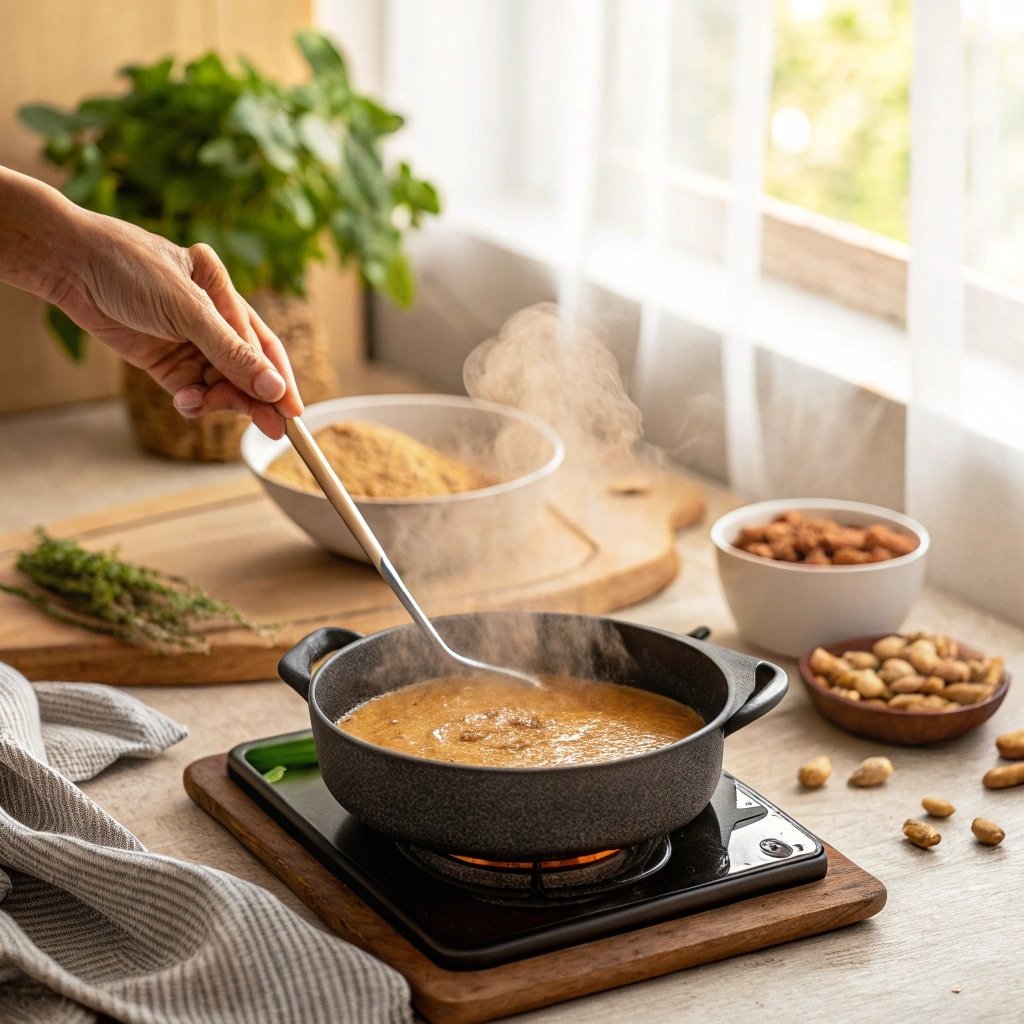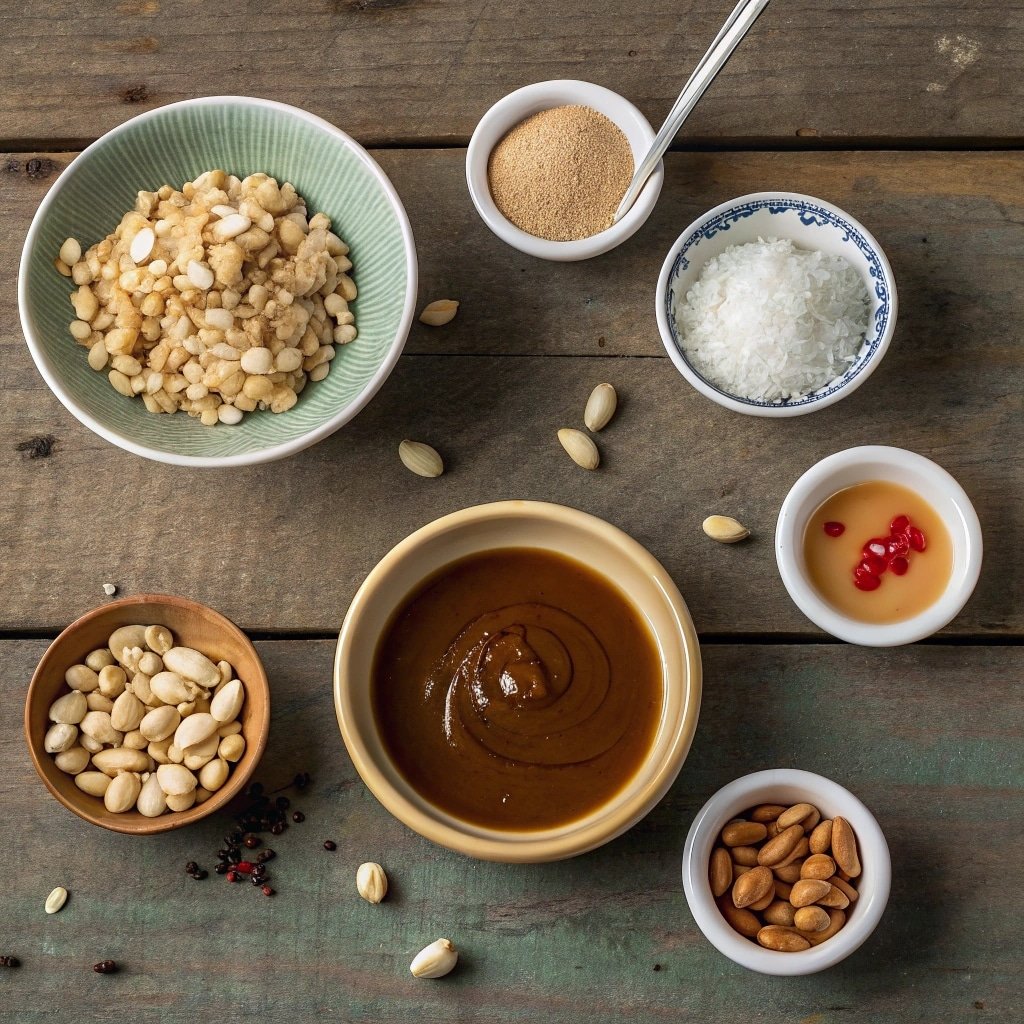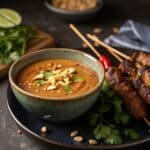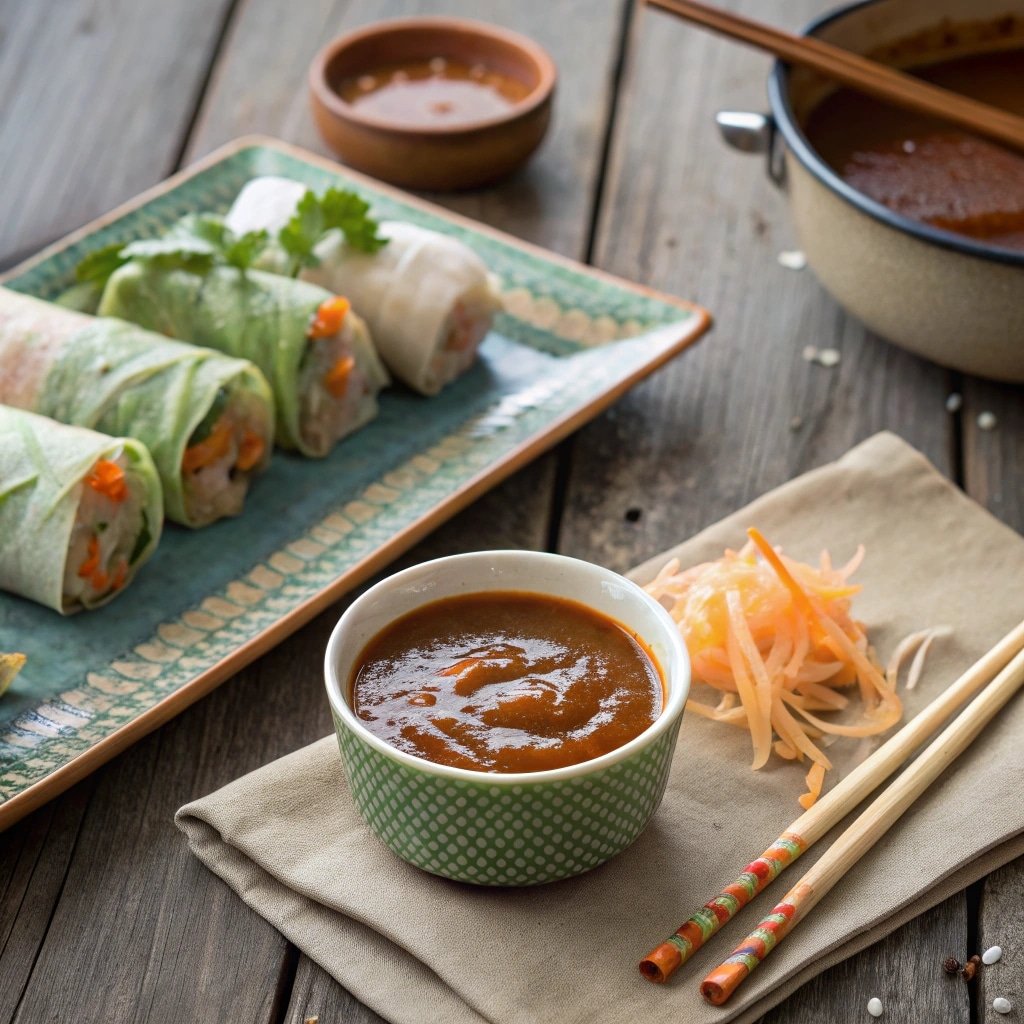Peanut sauce Vietnam is more than just a dip—it’s a rich, aromatic staple that captures the heart of Southeast Asian cuisine. From the first taste, it pulls you into a balance of sweet, salty, and savory flavors unlike any other. This article explores everything you need to know about peanut sauce Vietnam: its unique ingredients, how to make it, how it differs from Thai-style peanut sauces, and why it belongs in your everyday cooking. Whether drizzled over noodle bowls or served with fresh rolls, peanut sauce Vietnam adds unforgettable depth and warmth to every dish.
Table of Contents
The Story & Intro
How I Fell in Love With Peanut Sauce Vietnam
Growing up, sauces were everything in our kitchen—little bowls of flavor that brought life to every meal. But the first time I tasted peanut sauce Vietnam? That was something else. It was creamy yet light, savory with a hint of sweetness, and layered with umami that made every bite of Gỏi cuốn (fresh spring rolls) pop. My friend Linh’s mom made it for us after school. She blended peanut butter, hoisin sauce, garlic, and coconut water, stirred it gently, then topped it with crushed peanuts and chili oil. That first dip made me feel like I’d uncovered a secret recipe passed through generations.
Now, every time I stir together a fresh batch of peanut sauce Vietnam, I’m transported back to that kitchen—cross-legged on the floor, sticky fingers, laughter echoing through the room. It’s a sauce filled with comfort, connection, and culture.
Why Peanut Sauce Vietnam Deserves a Spot in Your Kitchen
Peanut sauce Vietnam isn’t just a condiment—it’s a foundation in Vietnamese home cooking. Unlike Thai peanut sauce, which leans into coconut milk and chili paste, Vietnamese peanut sauce uses hoisin to deliver a mellow sweetness and deeper complexity. This makes it perfect for dishes like Bún thịt nướng or as a dip for fresh rolls. It’s surprisingly quick to prepare, too—15 minutes on the stovetop and you’ve got a jar full of rich, authentic flavor.
When you make peanut sauce Vietnam yourself, you control the balance—spice, sweetness, texture. It’s easily adaptable, naturally gluten-free with the right ingredients, and vegan-friendly. This versatile sauce will quickly become a staple in your kitchen, one you’ll reach for again and again.
How to Make Peanut Sauce Vietnam at Home
Simple Ingredients, Big Vietnamese Flavor
One of the best things about making peanut sauce Vietnam is how effortless it is. You only need a few everyday ingredients, but when combined, they create a sauce full of deep, savory-sweet flavor with a creamy texture that’s perfect for dipping or drizzling.
Here’s what you’ll need:
Main ingredients:
- 3 tablespoons creamy peanut butter (unsweetened works best)
- 2 tablespoons hoisin sauce (adds sweet-savory depth)
- 1 tablespoon soy sauce (adds a savory umami flavor)
- 1 small garlic clove, minced (for aroma and edge)
- 1/4 cup coconut water or water (to thin the sauce)
- Optional: 1 tablespoon coconut milk (for creaminess)
Toppings and extras:
- Crushed roasted peanuts (for crunch)
- Chili oil or sriracha (for a touch of heat and bold flavor
- A touch of sugar or honey (if you like it sweeter)
- Lime juice (for a fresh zing, if desired)
These ingredients are flexible. You can adjust the saltiness, sweetness, or creaminess depending on what you’re serving it with. That’s the beauty of peanut sauce Vietnam—it’s easily personalized and always satisfying.


Foolproof Cooking Method
Begin by warming a small saucepan over low heat. Add a little neutral oil if you like, then sauté the garlic just until fragrant. Add in the peanut butter and hoisin sauce, stirring them together gently. Pour in the soy sauce and coconut water bit by bit, stirring constantly to make the sauce smooth.
Allow the mixture to simmer for a few minutes until it slightly thickens. Keep stirring so it doesn’t stick to the bottom. If it’s too thick, add more coconut water. If it’s too mild, adjust with a dash of sugar, chili, or lime.
Once the sauce is smooth and heated through, remove it from the heat and pour it into a bowl. Finish it off with a sprinkle of crushed peanuts and a drizzle of chili oil for the perfect final touch.
Peanut sauce Vietnam isn’t just delicious—it’s fast, flexible, and the kind of recipe you’ll reach for again and again.
Coming up next: we’ll show you how to use peanut sauce Vietnam in both traditional and unexpected ways, making your meals even more flavorful.
Print
Peanut Sauce Vietnam: How to Make the Authentic Vietnamese Version
- Total Time: 10 minutes
- Yield: 1 cup 1x
- Diet: Vegan
Description
Peanut sauce Vietnam is a rich, creamy, sweet-savory dipping sauce made with hoisin, peanut butter, and garlic. It’s a classic companion to spring rolls and grilled dishes in Vietnamese cuisine.
Ingredients
3 tablespoons creamy peanut butter
2 tablespoons hoisin sauce
1 tablespoon soy sauce
1 clove garlic, minced
1/4 cup coconut water or water
Optional: 1 tablespoon coconut milk
Crushed roasted peanuts (for topping)
Chili oil or sriracha (to taste)
1 teaspoon sugar or honey (optional)
Squeeze of lime juice (optional)
Instructions
1. Heat a small saucepan over low heat and lightly sauté the minced garlic until fragrant.
2. Add peanut butter and hoisin sauce, stirring until well combined.
3. Slowly whisk in the soy sauce and coconut water until the sauce reaches a smooth, pourable consistency.
4. Let the sauce simmer gently for 3–5 minutes, stirring constantly.
5. Taste and adjust with sugar, lime juice, or chili as desired.
6. Remove from heat and transfer to a serving bowl.
7. Top with crushed peanuts and a drizzle of chili oil before serving.
Notes
Store leftovers in a sealed jar in the fridge for up to one week.
To reheat, warm gently and add a splash of water or coconut milk to loosen the texture.
- Prep Time: 5 minutes
- Cook Time: 5 minutes
- Category: Sauce
- Method: Stovetop
- Cuisine: Vietnamese
Nutrition
- Serving Size: 2 tablespoons
- Calories: 80
- Sugar: 4g
- Sodium: 320mg
- Fat: 6g
- Saturated Fat: 1g
- Unsaturated Fat: 4g
- Trans Fat: 0g
- Carbohydrates: 5g
- Fiber: 1g
- Protein: 2g
- Cholesterol: 0mg
Keywords: peanut sauce Vietnam, Vietnamese peanut sauce, spring roll sauce
Versatile Ways to Use Peanut Sauce Vietnam
Classic Vietnamese Dishes That Shine With Peanut Sauce
Peanut sauce Vietnam was made to complement the fresh, vibrant flavors of many traditional Vietnamese dishes. If you’ve ever had Gỏi cuốn—fresh spring rolls with shrimp, herbs, and vermicelli—you know how essential a good dipping sauce is. The creamy, nutty flavor balances the freshness of the rolls perfectly. It’s the same with Bún thịt nướng, a grilled pork noodle bowl layered with fresh herbs, rice noodles, pickled vegetables, and crushed peanuts. A generous drizzle of peanut sauce Vietnam ties it all together with warmth and richness.
It also works wonderfully with grilled skewers like nem nướng (Vietnamese pork sausages), acting as both marinade and dip. You can even serve it with bánh xèo (crispy Vietnamese pancakes) instead of fish sauce for a twist that’s still full of authentic flavor.
Creative Ways to Use Peanut Sauce Vietnam Beyond Tradition
What makes peanut sauce Vietnam so unique is how well it adapts beyond its roots. It’s not just a dipping sauce—it’s a kitchen essential. You can stir it into cooked noodles for a quick, satisfying lunch, turning cold rice noodles into an instant noodle salad. Add shredded chicken or tofu, some sliced cucumber, and a handful of herbs, and lunch is served.
It’s also great as a sandwich spread. Try it in a bánh mì instead of mayonnaise for a deeper, nutty flavor. Or use it as a salad dressing base—just thin it with a splash of lime juice and water and toss with shredded cabbage, carrots, and herbs for a crunchy, refreshing side.
Need a last-minute glaze for grilled chicken or roasted vegetables? Warm a bit of peanut sauce Vietnam and brush it on during the final minutes of cooking. It caramelizes beautifully and adds bold flavor with almost no effort.
From traditional to modern, this sauce is endlessly useful. Once you start experimenting, you’ll find that peanut sauce Vietnam is the kind of staple that can quietly transform everyday meals into something special.
Next, we’ll explore how to store it, adjust it for different diets, and make it ahead—because having this sauce on hand means easier, better meals all week long.

Storage, Meal Prep, and Customization Tips for Peanut Sauce Vietnam
Make It Once, Use It All Week
One of the best things about peanut sauce Vietnam is how well it stores. Once prepared, it keeps beautifully in the fridge for up to a week in a sealed jar or container. In fact, the flavor deepens over time. The garlic mellows, the hoisin becomes more pronounced, and the overall taste becomes richer. Just give it a good stir—or a quick zap in the microwave—before serving.
If the sauce thickens too much after refrigeration, add a splash of water or coconut milk and stir until smooth. It’ll come right back to life, ready for noodles, veggies, wraps, or whatever you’re cooking.
Batch-prepping peanut sauce Vietnam means you’ve got a quick, flavorful solution on hand all week. You can use it as a quick lunch dressing, a dip for raw veggies, or a sauce for grilled meats and tofu. It makes healthy eating feel easy and exciting—because every meal gets a boost of flavor.
How to Adapt Peanut Sauce Vietnam to Any Diet
This sauce is naturally flexible and easy to adjust for dietary preferences. For a vegan version, simply ensure your hoisin sauce and soy sauce are plant-based (many brands are). If you’re gluten-free, swap the soy sauce for tamari or coconut aminos.
Watching your sugar intake? Go for natural peanut butter and use less hoisin, replacing it with a dash of soy sauce, a squeeze of lime, and a bit of maple syrup or monk fruit sweetener. For those who want it spicier, a little chili paste or sriracha will do the trick.
Peanut sauce Vietnam isn’t just about tradition—it’s about freedom in your kitchen. It’s stress-free, flexible, and friendly to nearly every diet. And it proves that a homemade sauce can make everyday cooking feel truly satisfying.
Whether you’re planning meals for the week, feeding a crowd, or just want something easy to elevate dinner, peanut sauce Vietnam delivers. It’s simple, flavorful, and endlessly adaptable—a true staple worth mastering.
Conclusion: A Staple Worth Savoring
Peanut sauce Vietnam is more than a dip—it’s a bridge between flavor and memory. Whether you’re enjoying it with crisp gỏi cuốn or drizzling it over grilled meats, it brings a creamy, comforting richness that’s unmistakably Vietnamese. From its simple ingredients to its incredible versatility, this sauce proves that a homemade touch makes all the difference.
In my kitchen, every time I stir together hoisin, peanut butter, and garlic, I’m reminded of that first time I tasted it in a friend’s home. It felt welcoming, nourishing, and real. That’s the magic of peanut sauce Vietnam—it turns everyday meals into something meaningful.
Now, it’s your turn. Keep a jar in the fridge, share it with friends, drizzle it on something new. Cooking should always feel like this: free to try, free to enjoy.
For More recipes Follow me in Facebook and Pinterest
FAQs About Peanut Sauce Vietnam
What is in Vietnamese peanut sauce?
Vietnamese peanut sauce typically includes creamy peanut butter, hoisin sauce, soy sauce, minced garlic, and either coconut water or water. It’s often topped with crushed roasted peanuts and a drizzle of chili oil. Some variations use fermented bean paste or coconut milk for added richness.
What’s another name for peanut sauce?
While “peanut sauce” is the common term in English, it doesn’t have a direct Vietnamese name. It’s often referred to simply as “nước chấm đậu phộng” (peanut dipping sauce) or “sốt đậu phộng.” In restaurants, it’s usually just called “peanut sauce” on English menus.
What culture is peanut sauce from?
Peanut sauce appears in many Southeast Asian cuisines, including Vietnamese, Thai, and Indonesian cooking. In Vietnamese cuisine, it is most often paired with fresh spring rolls (gỏi cuốn) and grilled meat dishes. Each culture uses different ingredients and flavor balances, making each version unique.
What is the difference between Thai and Vietnamese peanut sauce?
Thai peanut sauce often includes red curry paste, fish sauce, and a heavier use of coconut milk, creating a spicier and creamier profile. In contrast, Vietnamese peanut sauce uses hoisin sauce as a base, resulting in a sweeter, tangier, and lighter taste, perfect for balancing fresh herbs and grilled meats.

